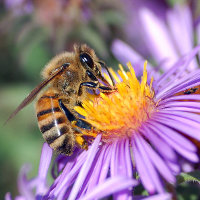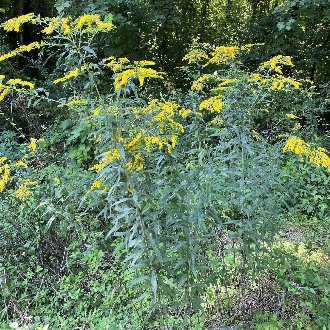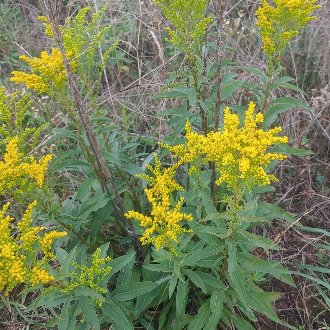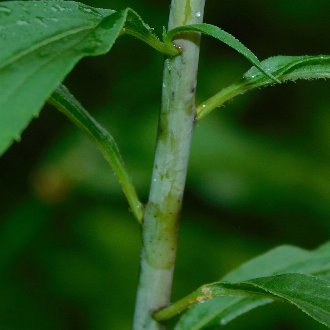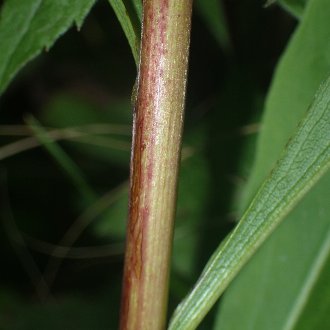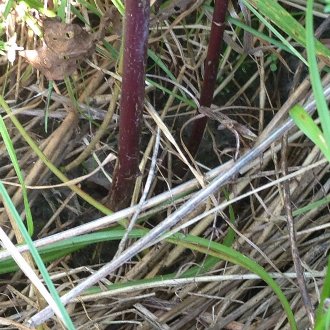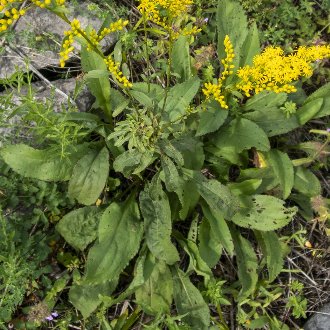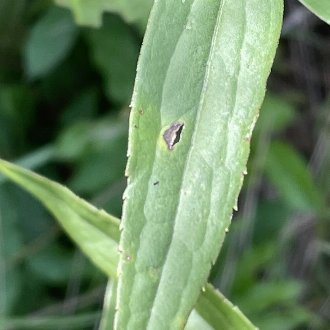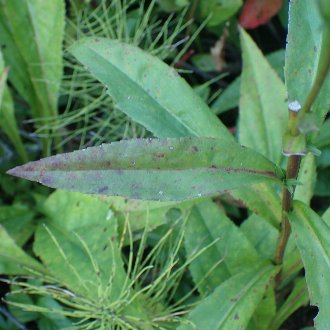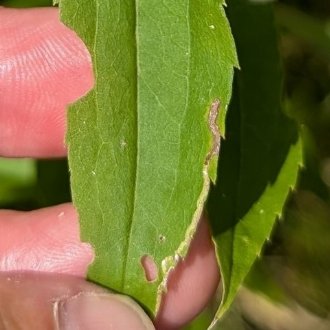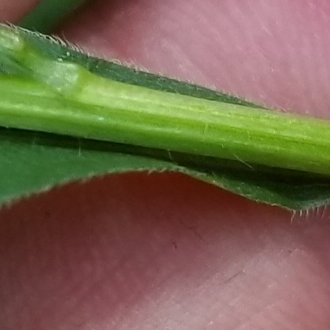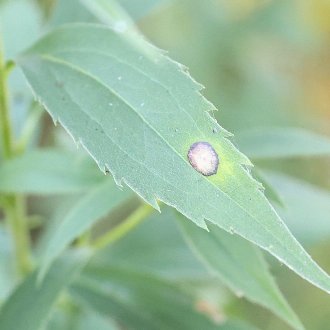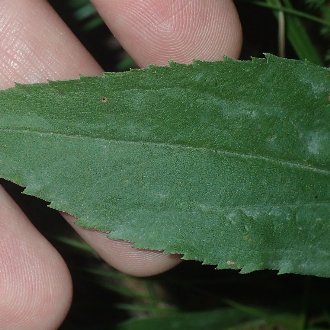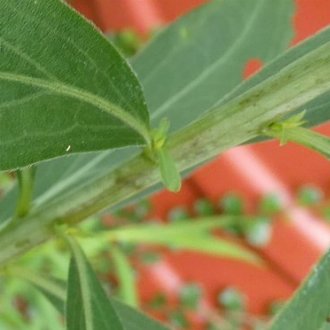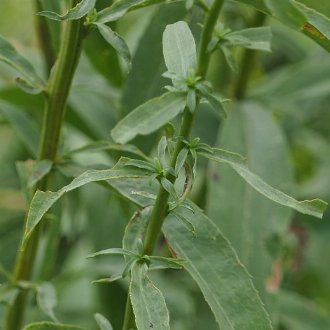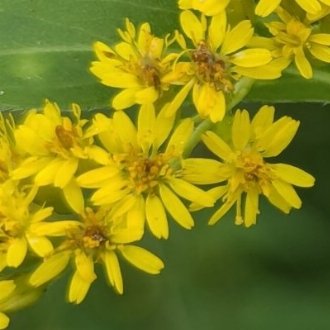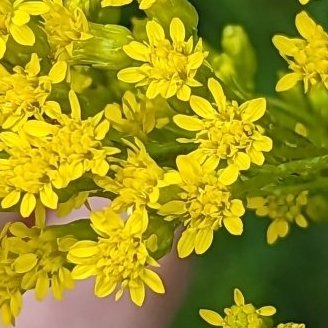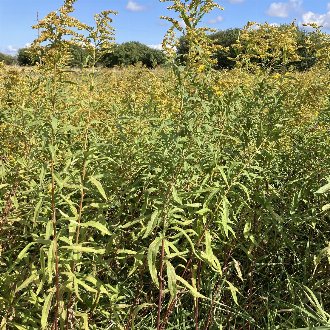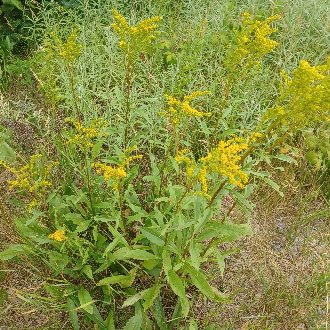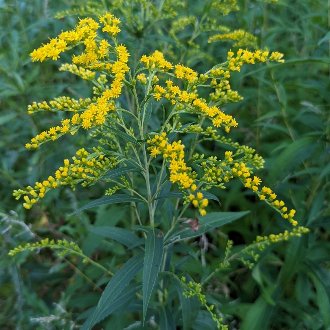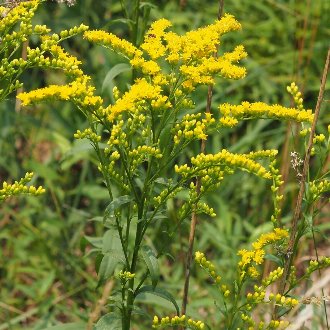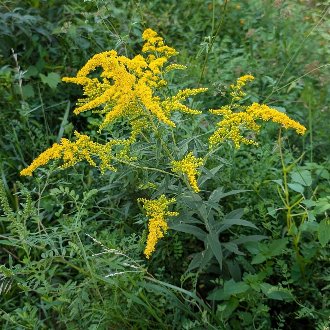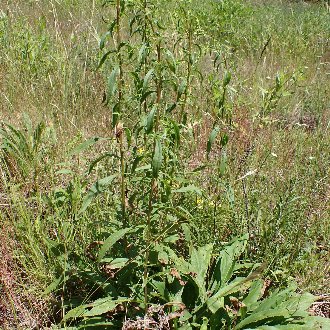Giant Goldenrod vs Early Goldenrod
These two goldenrods are sometimes confused, as both tend to bloom earlier and have relatively smooth stems and foliage. Both occur in sun to partial shade, but they otherwise have little habitat overlap. They are usually easily distinguished by growth habit, and they have numerous other differences. S. gigantea ranges much farther west and south, is more restricted to moist sites with richer soil, tolerates flooding and poor drainage, and is more competitive against tall herbaceous vegetation. S. juncea prefers drier sites where competing vegetation is sparser, and is more demanding of good drainage.
Giant Goldenrod (Solidago gigantea) | Early Goldenrod (Solidago juncea) |
A large, aggressive perennial of moist, rich sites, native to a wide range in North America. | A perennial, usually among the earliest blooming of the goldenrods. |
Plants average much taller (50-200cm or about 1½-6½ft) Photo © Becky Dill, Public Domain. | Plants average much shorter (30-120cm, or 1-4 feet) Photo © Scott Harris, CC BY 4.0. |
Stem is often, but not always glaucous (covered in a pale waxy coating.) Photo © Michael J. Papay, CC BY 4.0. | Stem is not glaucous. Photo © John Baur, CC BY 4.0. |
Plants lack basal leaves during the growing season. Photo © Matt Schultz, Public Domain. | Plants have robust basal leaves, usually retained year-round, including at the time of flowering and even in winter. Occasionally, plants may lack basal leaves at some times of year. Photo © Randy A Nonenmacher, CC BY 4.0. |
Leaves look distinctly triple-veined, with two major side-veins running parallel to the midvein, and nearly as prominent as it. Photo © Becky Dill, Public Domain. | Side-veins of upper leaves on the stem tend to be less prominent, leading them to look relatively featureless other than the central vein. Photo © John Baur, CC BY 4.0. |
Leaf margins are hairless. Leaf surfaces occasionally have some hairs, but are often smooth. Photo © Alan Prather, CC BY 4.0. | Leaf margins are ciliate (covered in tiny hairs), contrasting with the leaf surfaces, which are hairless both above and below. Photo © Daniel McClosky, CC BY 4.0. |
Leaf serrations average coarser, and are always at least somewhat visible to the naked eye. Plants retain coarse serrations higher up on the plant. Photo © Cole Wolf, CC BY 4.0. | Leaf serrations average finer and become so fine higher up on the plant that the leaf margins are often entire (without serrations) just under the inflorescence. Photo © John Baur, CC BY 4.0. |
Axils of upper leaves (where the base of each leaf meets the stem) may or may not have bundles of small leaves. If they do, the leaves are usually less developed and do not extend as far down the stem. Photo © Bruce Cook, Public Domain. | Axils of upper leaves more consistently have bundles of small leaves in them, and the leaves tend to be more well-developed and extend farther down the stem. Photo © mefisher, Public Domain. |
Flowerheads average more rays although with much overlap (usually 9-15, rarely 7-24). Photo © Skyler Principe, CC BY 4.0. | Flowerheads average fewer rays although with much overlap (usually 7-12). Photo © Skyler Principe, CC BY 4.0. |
Plants are more inclined to reproduce rhizomatously, and form larger colonies when they do. Photo © Derek, CC BY 4.0. | Plants are less likely to reproduce rhizomatously, and tend to form smaller colonies when they do. Photo © Quinten Wiegersma, CC BY 4.0. |
Branches of the inflorescence tend to be more spaced out along the main stem. Branches are more likely to have inconsistent curvature, with a sharp curve back near the base, but flattening out near their tips. Branch length is unequal, and uppermost branches are often much shorter than lower branches. Photo © Skyler Principe, CC BY 4.0. | Branches of the inflorescence tend to be densely packed together along the main stem. Branches have a more constant curvature over their length. Most branches are roughly equal in length. Photo © Kevin Faccenda, CC BY 4.0. |
Found in moist habitats with rich soil, where there is usually steep competition from other herbaceous vegetation. Photo © Alan Prather, CC BY 4.0. | Found in drier habitats with poorer soil, with or without some shade from overhead trees, but where there is usually less competition from herbaceous vegetation. Photo © Steven Lamonde, CC BY 4.0. |
Additional Notes
The lack of basal leaves of S. gigantea, as well as its greater height, reflect the heavy competition from other herbaceous plants in its habitats. Typically, little light reaches the ground in these habitats. In the habitats where S. juncea grows, however, there is less competition from herbaceous plants, and as such the basal leaves are beneficial, and the plant does not need to grow as tall to reach light. There may, however, be some overhead shade from trees, so the plant often has a growth habit with numerous, broad leaves to maximize light capture. The shorter, bottom-heavy growth habit of S. juncea also makes it more drought-resistant, as wind speeds are lower closer to the ground.References & External Resources
These short lists show only links helpful for ID. For a complete list of references and resources also covering other aspects of ecology, visit the links section of the full article on each plant, which is the first entry here.

